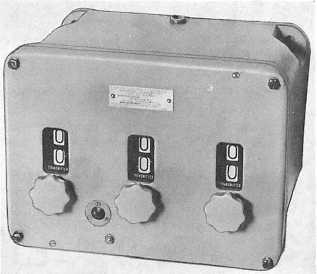| |
order by moving an answering pointer into the
same sector as the requesting pointer from the
bridge.
Engine-Revolution Indicator
Near the engine-order telegraph, you normally
will find another device, the engine-revolution
indicator (fig. 18-6).
On the face of this instrument are three small
windows with two rows of numbers in each
window. The lower row of numbers is set
individually by three hand knobs located directly
below the windows. For example, if 110 shaft
revolutions per minute is required for a ship to
proceed at 15 knots, the lee helmsman would
indicate the numbers 1, 1, and 0 in the lower row
of numbers. These lower numbers give a visual
indication of the shaft revolutions ordered by the
conning officer to the engine room. Through
electrical transmission, corresponding numbers
appear on a similar instrument in the engine
room(s). In the engine room(s), these orders are
receipted and acknowledged when the engine-
room instrument is set on the same settings. Once
again this indication is transmitted back to the
bridge electrically and is shown on the upper row
of numbers. Thus, the lee helmsman is able to
report to the conning officer the receipt of the
order for engine speed and see that the order is
being carried out.
7.122
Figure 18-6.-Engine revolution indicator.
The number of revolutions per minute required
to travel at the various speeds (in knots) is
calculated in advance and is posted on a table near
the lee helm.
On older ships the helm and the lee helm are
located in different consoles, usually near each
other. On newer ships, however, a ship-control
console houses all the equipment for steering the
ship and for controlling its speed in one central
location. Additionally, on some ships you will find
lighting, steering, and general-alarm controls
housed in the ship-control console.
COMPASSES
The best known and most widely used naviga-
tional instrument is the compass. Without it,
precise information on headings and directions
would be almost impossible to obtain. Compasses
were used even before the days of Columbus, and
they remain indispensable to today’s Navy.
A compass is an instrument that indicates the
fixed point or direction of north. It allows you to
judge all other directions by this fixed point to
determine the direction in which you are heading.
The Navy uses two main types of compasses:
gyroscopic and magnetic. The gyrocompass
operates on the principle that a rapidly spinning
object is balanced at its center of gravity, much as
a spinning top stands on its point. The
gyrocompass is designed to point toward true
north, although it may have a slight mechanical
error (for which an allowance is made). On the
other hand, the magnetic compass is controlled
primarily by the magnetic properties of the earth;
therefore, it tends to point toward the magnetic
north pole.
GYROCOMPASS
The gyrocompass is unaffected by magnetic
influence. When in proper working order, it points
constantly to the true rather than the magnetic
north pole.
The gyrocompass may have a slight mechani-
cal error of 1 or 2 degrees, but the error is
computed easily. Since the error remains constant
18-6
|

